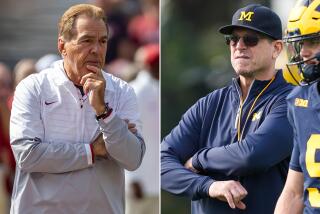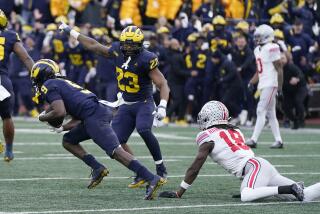Football’s total blitz on cable and network TV
- Share via
“American Idol” fired judges, “The Tonight Show” is a punch line and viewers keep splintering across the channel landscape, but there’s at least one sure thing in the TV business: Football rules the airwaves in 2010.
In a striking display of ratings prowess, the opening games of the college and pro football seasons drew record audiences, further cementing the sport’s position atop America’s sports-media food chain.
Already this month, NBC had the most-watched regular-season National Football League game ever shown in prime time, and Fox’s ratings for the opening weekend of NFL games were the network’s best Week 1 numbers since it began showing pro games in 1994.
Through two weeks of the NFL season, viewership of CBS’ American Football Conference games are up nearly 20% compared to last year, and NBC’s Thursday night season opener between New Orleans and Minnesota, which featured halftime entertainment from the Dave Matthews Band and country star Taylor Swift, attracted about 25 million viewers and was the most-watched program on TV since the Oscars.
As was the case during the salad days of “Idol” or “Who Wants to Be a Millionaire,” there appears to be an insatiable TV appetite – this time, for footbal. There’s more pigskin on than ever, especially college ball, but instead of shrinking audiences for individual games, the orgy of coverage is producing new ratings benchmarks, even for games that are hardly marquee matchups.
The ultimate symbol of football’s current TV clout might be the Sept. 6 game between Boise State and Virginia Tech, broadcast by ESPN. While Boise State has become something of a media darling in recent years and Virginia Tech came into the game ranked No. 10 in USA Today’s preseason poll of coaches, neither team has nearly the national following of stalwarts such as Notre Dame, Texas or USC, and the game kicked off at 8 p.m. Eastern time, in the waning hours of Labor Day weekend.
No matter: Boise State’s thrilling 33-30 victory, which ended near midnight on the East Coast, was watched by nearly 10 million viewers and was the most-viewed program of the day on all networks — cable and broadcast.
College football “is probably the most meaningful regular season in the entire sports world, and that resonates incredibly well with people,” says ESPN Vice President of Programming Dave Brown, who has been at the network for 23 years and helps manage its college football coverage. “This is one sport that can turn on a dime every weekend.”
There’s no magic-bullet theory to explain the surging viewership: Few fans would argue that we’re living in a golden age of football talent. But executives across the TV and sports industries cite at least three factors: (1) The quality of high-definition broadcasts and the dramatically lower prices for HD sets, which has made home viewing more accessible and enjoyable for a wider audience; (2) The popularity of “fantasy football” is giving more fans a reason to watch games they otherwise would skip; and (3) pro and college football have fewer — and hence more meaningful — games and are mostly played on one day of the week, making them easier to follow in a short-attention-span era, particularly compared with sports such as baseball and basketball, whose seasons are much longer and harder to follow for casual fans.
If anything, the sport’s appeal on TV, particularly in the case of pro football, is affecting attendance at the actual games. The NFL expects overall attendance to drop for the third consecutive year, despite several teams moving into larger facilities in recent years. The league anticipates that average game attendance will dip below 65,000 this season, the lowest figure since 1998, according to an interview with NFL executive vice president Eric Grubman published earlier this month in USA Today.
On Saturdays in L.A., there’s a college game on an ESPN-affiliated network from dawn to nearmidnight. College football is in ESPN’s corporate DNA: The sports-media company was founded, in part, to televise University of Connecticut football games, and back when ESPN was a cable upstart that aired reruns of Australian Rules Football, Division I college football was one of its only high-profile properties. Now, of course, ESPN is a sprawling content behemoth that spans far beyond TV, but college football is still a huge priority. This year, ESPN will broadcast games on five networks, including ABC, its corporate cousin — and increasingly, its little brother — at Disney, as well as on a new 3-D channel.
For the last five years, ABC has been broadcasting games in prime time on Saturday, though those telecasts are branded as ESPN productions and largely feature ESPN talent. ESPN is also making a bigger push for West Coast viewers by putting more Pac-10 games than ever (four) in its exclusive Thursday night package and showing two conference games, including UCLA vs. Arizona State, on the Friday after Thanksgiving. ESPN is also giving the league more national exposure by showing several Pac-10 Saturday night games, such as next weekend’s Stanford-Oregon tilt, after the East Coast prime-time games.
While CBS has one Saturday evening game as part of its media deal with the powerful Southeastern Conference, the ABC Saturday night package is the only college football series that appears weekly in prime time. The ABC games often go head-to-head with other ESPN games, and the results haven’t been entirely favorable for ABC — ratings for their Saturday night games dipped slightly last year compared with 2008. But the competition hasn’t hurt ESPN or ESPN2, each of whose viewership numbers increased slightly last year. “You gain more by having a bigger pool of viewers,” Brown says. “It’s been additive rather than [ABC] sucking out viewers from cable.”
The college football media landscape also now includes the lucrative Big Ten Network, which is co-owned by the athletic conference and News Corp.’s Fox Sports Networks unit. Launched in 2007 amid much naysaying, its success in attracting subscribers and fees — it now counts around 40 million subscribers and generated nearly $183 million in subscriptions in 2009, according to media analyst SNL Kagan — has motivated other conferences and even individual schools, including the University of Texas, to explore launching their own networks.
Last year, the Pacific 10 Conference hired Creative Artists Agency to advise it on media rights and the potential creation of a Pac-10 network. Earlier this summer, the Pac-10 agreed to have the universities of Colorado and Utah join the league next year, and actively courted Texas, Oklahoma and several other teams of the Big 12 conference. The goal: to expand into influential TV markets and increase the conference’s fan base and geographic footprint, thereby making a new Pac-10 network more appealing to cable systems, satellite operators and, of course, fans.
“We’re going to develop a robust business plan,” says Pac-10 Commissioner Larry Scott, hired last year after a stint heading the Women’s Tennis Assn. “I think our conference is well-suited for a network.”
calendar@latimes.com
More to Read
Go beyond the scoreboard
Get the latest on L.A.'s teams in the daily Sports Report newsletter.
You may occasionally receive promotional content from the Los Angeles Times.










